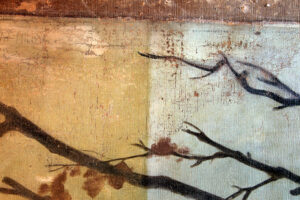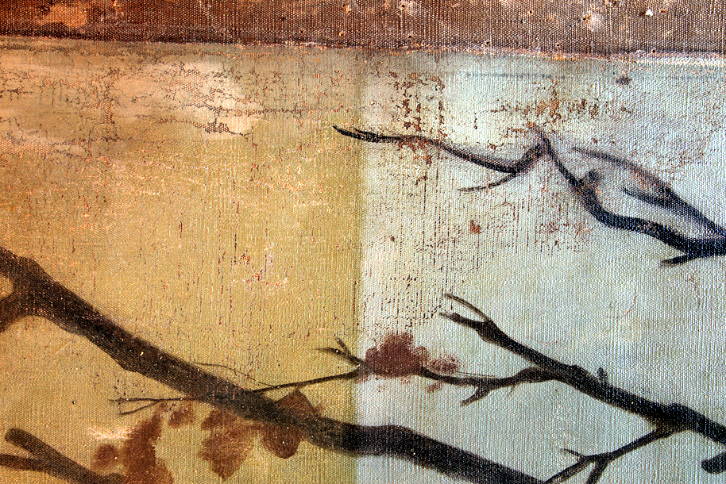In the case of C.L.L. Muller’s work “30th March 1814” (P.161) the painting surface was covered with dust and years of deposits. A dark yellowish veil covered the entire surface. The varnish that had protected the colour layer for so many years was heavily oxidised and worn, it was now altering the aesthetic effect of the work and had to be removed.
Initially, dry cleaning was carried out, i.e. dust and surface dirt were removed from the painted surface of the work, using a soft brush and a special vacuum cleaner (dry cleaning).
By wet cleaning, i.e. using a mixture of solvents, the National Gallery’s conservators removed the oxidised varnish covering the painting surface in sections, as well as the paintings covering mainly worn parts of the paint layer. (Figure 1)
The removal of the varnish coating began to be carried out around the perimeter, and to enable the conservators to reach central parts of the painting they worked on the special bridge that was constructed for maintenance work when the work was in a horizontal position.
During the removal of the heavily oxidized coating, with the use of a cotton swab and a mixture of solvents, the painter’s brushwork and colour palette were slowly revealed. Figures and details in the work that for years had been hidden under the dark yellowish veil were revealed. The resulting result is particularly striking.
The conservators of the OPMAS worked on the special bridge that was built to allow them to access central points of the painting, for conservation work that required the work to be in a horizontal position.

Cleaning the back side of the project
After the cleaning of the front side of the work was completed, then, with the help of a specialized art handling crew, the work was turned face down.
Cleaning of the back side began with the removal of the old local patches. A total of seven local patches were removed, six small and one large, which had been previously placed to reinforce the original fabric of the work in areas where there were holes and tears. The local patches were removed mechanically (using a scalpel and a special spatula) and a special solvent mixture.
Subsequently, deposits and surface contaminants were removed mechanically from the rear side using scalpels, brushes and a vacuum cleaner.


